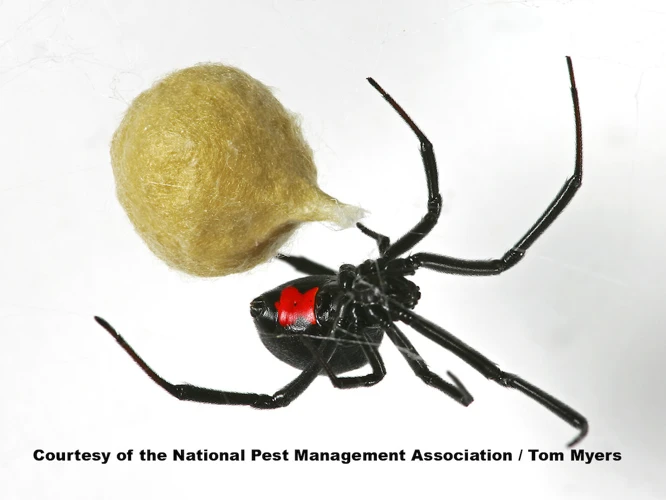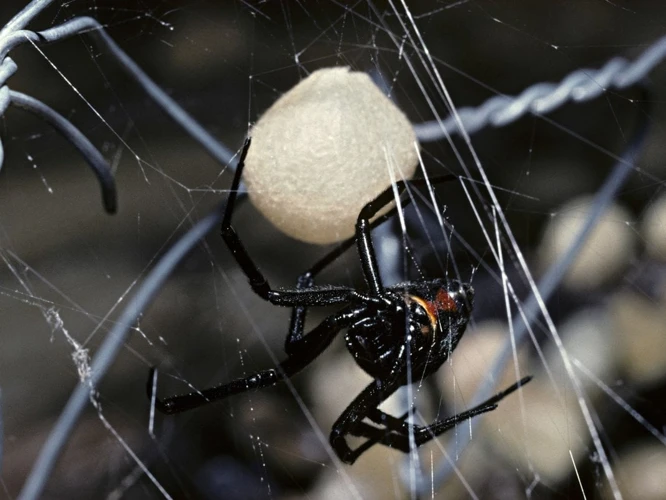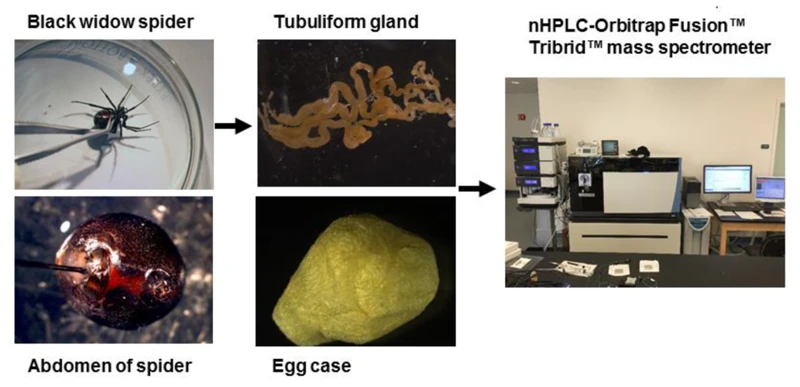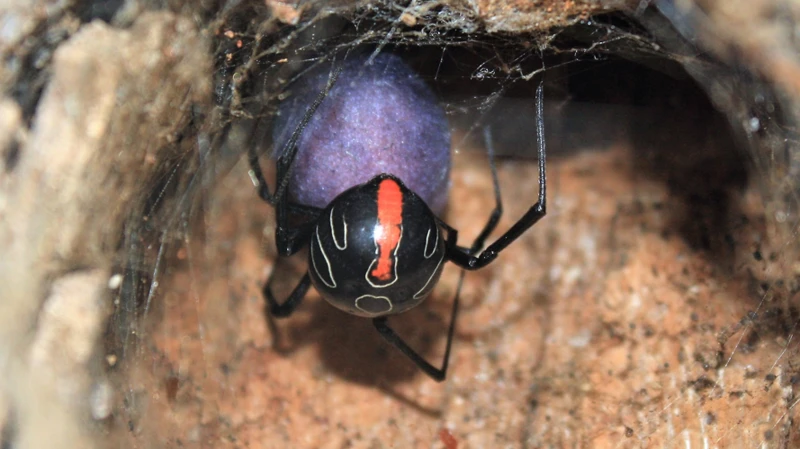Introduction to Black Widow Spider Eggs

Black widow spiders are notorious creatures known for their venomous bite, but did you know that they also have a unique way of reproducing? Female black widow spiders lay eggs in a silk sac called an egg sac. These sacs protect the eggs from predators and other potential dangers until they hatch.
The development of black widow spider eggs is a fascinating process that has been studied extensively by researchers over the years. The study of black widow spider eggs provides insight into the reproductive and maternal behavior of these spiders, as well as the potential impact on their populations and surrounding ecosystems.
During the egg stage, black widow spiders face a variety of challenges, such as cannibalism among siblings and predation from other animals. Despite these challenges, black widow spider eggs are able to hatch and develop into fully-formed offspring thanks to their adaptive capabilities in a variety of environments.
Over the years, several methods have been used to study black widow spider eggs, including observing their behavior and reproduction and conducting DNA testing to learn more about their populations. Through these studies, researchers have uncovered interesting findings about the role of parental care in offspring survival, the adaptive capabilities of black widow spiders in different environments, and the potential impact of black widow spider populations on biodiversity and conservation strategies.
The study of black widow spider eggs is an important aspect of research into these fascinating creatures. By understanding their reproduction and maternal behavior, as well as their impact on surrounding ecosystems, we can better protect these spiders and their habitats. If you’re interested in learning more about black widow spider eggs and their development, check out our articles on topics such as egg sac placement, hatching, and maternal care.
History of Black Widow Spider Eggs Research

The history of black widow spider egg research is a long and fascinating one. Scientists have been studying these spiders and their egg-laying behaviors for many years, and much has been learned about how these creatures reproduce and how they care for their young.
One of the earliest studies on black widow spider eggs was conducted in the mid-1800s. Researchers at the time were interested in better understanding the reproductive habits of these spiders, as well as the ecological role they played in the ecosystems in which they lived. This early research laid the foundation for further studies on the topic.
Over time, as technology and research methods improved, scientists began to delve deeper into the world of black widow spider eggs. They faced numerous challenges in their research, including the difficulties of observing these secretive creatures in their natural habitats and the dangers of handling such venomous spiders.
Despite these challenges, researchers persevered and made many interesting findings about black widow spider eggs. For example, they discovered that female spiders are highly selective about where they place their egg sacs, carefully choosing locations that offer the best chance of survival for their offspring. They also found that black widow spiders engage in cannibalism, with females sometimes eating their own eggs in order to ensure the survival of their remaining offspring.
In more recent years, studies on black widow spider eggs have focused on a range of topics, including the development of the eggs, the ecological importance of the egg stage, and the role of parental care in offspring survival. Scientists have used a variety of research methods to tackle these questions, from observing the behavior of wild spiders to conducting genetic testing and DNA analysis.
Black widow spider egg research has provided fascinating insights into the reproductive behavior and habits of these creatures. It has also shed light on the complex ecological systems in which they live, and on the important role that these spiders play in maintaining biodiversity. Those interested in learning more can explore resources such as /egg-development-black-widow-spiders/ or /hatching-black-widow-eggs/.
Early Studies on Black Widow Spider Eggs
Early studies on black widow spider eggs were conducted with great difficulty, as the spiders’ notoriously aggressive behavior made them difficult to observe in their natural habitat. Nevertheless, some groundbreaking research was conducted in the early 20th century, shedding light on the reproductive biology of these fascinating arachnids. One of the earliest discoveries was that black widow spiders produce distinctive egg sacs, which are carefully placed in protected locations. In fact, understanding the placement of egg sacs remains an important area of research to this day, as it sheds light on the spiders’ ecological behavior. Research on egg sac placement has revealed that black widows often choose sites that protect their developing offspring from predation and environmental hazards, highlighting the importance of maternal care in the survival of young spiders.
Challenges Faced in Research
Researching Black Widow spider eggs is no easy task. One of the main challenges faced by researchers is the sheer elusiveness of Black Widow female spiders. These creatures are solitary and are known to hide and weave their egg sacs in some of the most difficult-to-reach places. As a result, it’s challenging to study their behavior and reproduction in natural environments.
Another challenge that researchers face is the high mortality rate of Black Widow spiderlings. During the developmental stage, many spiderlings may succumb to cannibalism or predation by larger spiders or insects, which could affect the population of Black Widows in any given area.
This low survival rate also raises ethical concerns when conducting studies in a laboratory setting. Researchers must provide specific conditions to ensure the safety and survival of the spiderlings, which is time and resource-intensive.
Furthermore, studying the genetics of Black Widow spiders is another scientific challenge researchers face. Due to the small size of eggs, obtaining enough DNA for analysis can be challenging. However, some discoveries have been made using modern gene sequencers, which provide scientists with a better understanding of the genetic makeup of these creatures.
All of these challenges can make it difficult for researchers to study the intricacies of Black Widow spider eggs. As a result, multiple methods have been employed to understand the phenomenon, such as observing Black Widow spider behavior and reproduction in their natural habitats, conducting lab experiments to supplement natural observations, and assessing spider DNA using specialized equipment.
Despite these challenges, researchers have made some fascinating discoveries about Black Widow spider eggs and the species as a whole. For instance, there’s evidence suggesting that parental care plays a significant role in the survival of offspring. Additionally, Black Widows are known to adapt to different environments and can thrive in various sub-tropical climates, making them a resilient species.
Understanding the challenges that researchers face when studying Black Widow spider eggs provides greater insight into the intricate nature of these fascinating creatures. By working to overcome these hurdles, we can continue to learn more about the spiderlings and their impact on local ecosystems.
Research Methods Used to Study Black Widow Spider Eggs

Scientists have employed different research methods and techniques to study Black Widow Spider eggs. These methods have not only helped researchers to understand the reproductive behavior of these spiders, but have also led to some fascinating discoveries.
Observing Black Widow Spider Behavior and Reproduction: One of the primary research methods used to study Black Widow Spider eggs is by observing their behavior and reproduction. Scientists have observed that Black Widow Spiders exhibit sexual cannibalism, wherein the female spider cannibalizes the male after mating. Additionally, they have also observed that female Black Widow Spiders store the sperm received during mating and can fertilize multiple egg sacs with a single mating. Scientists have also observed that the female Black Widow Spider creates silk egg sacs that contain between 200 and 900 eggs, which she closely guards.
Using DNA Testing to Study Reproduction and Population: Another method that has been used to study Black Widow Spider eggs is DNA testing. This technique has helped researchers to study the genetics of Black Widow Spider populations as well as to determine the paternity of the offspring. DNA testing has also revealed that offspring from different egg sacs can have different fathers, which is a unique reproductive strategy for these spiders.
These research methods have led to some intriguing findings about the behavior and reproduction of Black Widow Spiders. For example, maternal care is extremely important for offspring survival in these spiders, and female Spider Black Widows often cannibalize their own eggs to provide sustenance to their young. Additionally, environmental factors such as temperature have been shown to impact Black Widow Spider egg development and offspring size.
If you are interested in learning more about black widow spider egg research, check out our article on the ecological importance of the egg stage in Black Widow Spiders.
Observing Black Widow Spider Behavior and Reproduction
One of the most fascinating ways to study black widow spider eggs is through observing their behavior and reproduction. Researchers have discovered many interesting insights into the lives of black widow spiders through direct observation, and this has helped to shed light on their unique reproductive strategies and behaviors. These spiders are known for their highly advanced reproductive systems and territorial behavior, and by studying these traits up close, scientists have gained valuable insights into their complex biology. For example, it has been observed that female black widow spiders will engage in egg cannibalism in order to gain nutrients in times of scarcity. This strategy may help ensure the survival of the strongest offspring. Additionally, researchers have discovered that male black widow spiders store sperm inside their bodies for long periods of time, which allows them to continue mating even after they have left the immediate vicinity of a female. These and other observations have helped researchers better understand the unique biology of black widow spiders.
Using DNA Testing to Study Reproduction and Population
Through DNA testing, scientists have been able to gain a better understanding of the reproduction and population of black widow spiders. One study conducted by researchers at the University of Toronto used genetic markers to examine the genetic diversity and relatedness of different black widow populations in North America. The results revealed that there was gene flow between different regions, but also distinct subpopulations within each region.
The use of DNA testing has also shed light on the mating strategies of black widows. Females have been found to store sperm from multiple males, allowing them to choose the best sperm for fertilization and potentially leading to increased genetic diversity within populations. In some cases, sperm storage can also allow females to lay multiple clutches of eggs with different paternity, providing a form of insurance against predation or environmental stress.
Interestingly, research has also shown that black widow mothers may selectively cannibalize certain eggs within their egg sacs, potentially improving the chances of survival for the remaining offspring. This type of behavior is thought to be a form of maternal care, where the female sacrifices some of her own reproductive investment to enhance the fitness of the remaining young.
DNA testing has proven to be a valuable tool in understanding the intricate reproductive strategies and population dynamics of black widow spiders. As more research is conducted in this field, we may gain even greater insight into the fascinating biology of these enigmatic arachnids.
To learn more about the predation of black widow spider eggs, check out our article on predation of black widow spider eggs.
Interesting Findings and Implications of Black Widow Spider Egg Research
After years of research, scientists have uncovered some fascinating findings about black widow spider eggs. One interesting discovery is the role of parental care in offspring survival. Female black widows guard their eggs and provide maternal care by protecting them and keeping them clean. This parental care significantly increases the chance of survival for the eggs and helps the offspring to grow stronger.
Another significant discovery is the adaptive capabilities of black widow spiders in different environments. Recent studies suggest that black widow spiders adjust their reproductive strategies according to their surroundings. For instance, in areas with low prey density, black widows invest more in reproduction in terms of producing larger egg sacs and more focused maternal care.
The implications of black widow spider egg research go beyond understanding the spiders themselves. This study also contributes to biodiversity and conservation strategies. As black widow spiders are a crucial part of the ecosystem, understanding their reproductive biology is essential for developing effective conservation measures.
Researchers have also found that female black widows exhibit egg cannibalism under stressful environmental conditions. When females are starved or kept in lower temperature conditions, they might resort to consuming some of their own eggs to survive.
Lastly, DNA testing has been a significant tool in helping scientists understand the reproductive behaviors of black widows. It has provided insights into the sperm-storage processes in females, such as how they manage to fertilize their eggs up to 14 months after mating. It has also helped to uncover the specific genes that are involved in the regulation of reproductive behaviors in spiders.
The discoveries made by black widow spider egg research have significantly broadened our understanding of these fascinating creatures and their importance in their environments. Further research will undoubtedly continue to help reveal new insights into the life of these spiders and their contribution to the ecosystem.
The Role of Parental Care in Offspring Survival
As fierce and dangerous as black widow spiders are known to be, their family dynamics are surprisingly complex and nurturing. A mother’s care plays a crucial role in the survival of her offspring. The phenomenon of maternal care and how it affects the development and survival of black widow spider eggs have been studied by researchers for years. In this section, we’ll explore the fascinating discoveries and implications of parental care in black widow spider populations. From egg cannibalism to the use of silk to protect eggs, we’ll delve into the measures that black widow spider mothers take to ensure that their offspring thrive in the wild.
Adaptive Capabilities in Different Environments
When it comes to the adaptive capabilities of black widow spiders, their ability to survive and thrive in different environments is truly impressive. As a species, these spiders have been found in various habitats, including deserts, forests, and even suburban areas. This section of the article will explore some of the ways in which black widows have adapted to different environments.
One way black widows have adapted is through their ability to store sperm for long periods of time. As discussed in the section on using DNA testing to study reproduction and population, female black widows store sperm from multiple males, which can increase their chances of producing offspring even when males are scarce. This adaptation allows black widows to maintain genetic diversity even in areas where there is a limited number of potential mates.
Another interesting adaptation is their cannibalistic tendencies. As explored in the section on egg cannibalism, female black widows will often eat some of their own eggs to provide energy for themselves and their remaining offspring. This adaptation allows them to survive in environments where food is scarce or unpredictable.
Finally, maternal care of their egg sacs is another important adaptation of black widow spiders. As discussed in the section on maternal care of black widow spider eggs, female black widows will guard and protect their egg sacs from predators and other threats. By doing so, they increase the survival rate of their offspring, which is essential in environments where predation is high.
To summarize this section, black widow spiders have several unique adaptations that allow them to survive and thrive in different environments. These adaptations include their ability to store sperm, their cannibalistic tendencies, and their maternal care of their egg sacs. By adapting to their surroundings in these ways, black widows have become a successful and widespread species.
The Effect on Biodiversity and Conservation Strategies
Research on black widow spider eggs has shown that they can have a significant effect on biodiversity and conservation strategies. Black widow spiders, as apex predators, play an important role in controlling the insect population and maintaining the balance of the ecosystem. Research on the eggs and reproductive behavior of these spiders can provide crucial insights into the health and stability of an ecosystem and the measures required for its conservation.
One study of black widow spider populations found that environments with higher amounts of vegetation had denser populations of black widows. The study also showed that the cannibalistic behavior of black widows, where females eat males after mating, does not necessarily lead to population decline. Rather, it could lead to a balanced gender ratio in populations. These findings highlight the adaptability of this species to different environments and the importance of considering this adaptability in conservation efforts.
Another study focused on the maternal care of black widow spider eggs. It found that mother spiders would defend their eggs against predators and adjust their behavior based on temperature changes. The study also showed that the lifespan of the mother spider correlated with the growth rate of the eggs and that eggs hatching later in the season tend to have lower survival rates. These findings demonstrate the significance of maternal care in the survival and health of black widow spider populations.
Given the role of black widow spiders in ecosystem balance and their potential vulnerability, research on their eggs can inform conservation strategies. By studying the environmental factors that affect black widow spider populations and the behaviors and characteristics that impact the survival of their eggs, conservationists can better understand how to protect this species. Additionally, understanding the adaptability of black widow spiders to different environments and their reproductive strategies can help in making informed decisions regarding the management and conservation of species in general.
While research on black widow spider eggs can provide valuable insights into the biology and behavior of this species, it can also have a broader impact on conservation efforts and the preservation of biodiversity. It is essential to continue studying this fascinating species to ensure a healthy and stable ecosystem.
Conclusion: The Importance of Black Widow Spider Egg Research and What lies Ahead
The study of black widow spider eggs is crucial for understanding the behavior and reproduction of these dangerous arachnids. Through early research and modern methods such as DNA testing, scientists have discovered various aspects of black widow spider reproduction, including the role of parental care in offspring survival and the adaptive capabilities of these spiders in different environments.
One intriguing finding is the prevalence of egg cannibalism in black widow spiders, where females consume their own eggs for various reasons. Additionally, research on the temporary nature of black widow egg sacs has indicated that these spiders have adapted to their surroundings, with some species building webs in areas with less disturbance to better protect their offspring.
Another interesting topic of study is the storage of sperm within female black widows, allowing them to fertilize multiple egg sacs over an extended period of time. Maternal care is also a vital part of black widow spider reproduction, as the survival of offspring depends on the mother’s protection, feeding, and grooming.
There is still much to learn about black widow spiders and their eggs. Future research could focus on the effects of habitat destruction and climate change on black widow spider populations, as well as conservation strategies to protect these spiders and their ecosystems.
Understanding the discovery and study of black widow spider eggs is essential to gaining insight into their unique behavior, reproduction, and adaptation. Its implications stretch beyond the scientific community and into understanding the effects of these spiders on biodiversity and the environment.
Frequently Asked Questions
1. Can you identify black widow spider eggs?
Black widow spider eggs are small, round, and white or cream-colored. They are usually found in a silken sac that is roughly the size of a marble.
2. Are black widow spiders dangerous?
Yes, black widow spiders are venomous and their bites can be painful and potentially lethal. It is important to seek medical attention if you are bitten by a black widow spider.
3. How do black widow spiders reproduce?
Female black widow spiders typically lay eggs in a silken sac which they guard and care for until the spiderlings hatch.
4. What is the significance of black widow spider egg research?
Research on black widow spider eggs can help us better understand spider behavior, reproduction, and adaptation to different environments. It can also inform conservation strategies and the management of potentially dangerous spider populations.
5. How do scientists study black widow spider eggs?
Scientists use various methods to study black widow spider eggs, including observing spider behavior and reproduction in the field, DNA testing to study population and genetic diversity, and controlled laboratory experiments.
6. Are there any unique features of black widow spider egg sacs?
Yes, black widow spider egg sacs are known for their tough, papery texture and distinctive shape. They are often round and have a crumpled or lumpy appearance.
7. What is the role of parental care in black widow spider reproduction?
Female black widow spiders provide extensive parental care to their offspring, including guarding the egg sac, feeding spiderlings, and protecting them from predators.
8. How do black widow spiders adapt to different environments?
Black widow spiders have adapted to a wide range of environments, from deserts to forests. They are able to survive in these diverse habitats by changing their diet, behavior, and other physiological features.
9. Are there any current conservation strategies in place to protect black widow spider populations?
Conservation strategies for black widow spiders include creating protected areas and habitat restoration programs, educating the public about spider behavior and safety, and using integrated pest management techniques to reduce human-spider interactions.
10. What are some future directions for black widow spider egg research?
Future research on black widow spider eggs could focus on the genetic and epigenetic factors that affect spider behavior and survival. Additionally, researchers may study the ecological and evolutionary implications of black widow spider populations in different environments.






